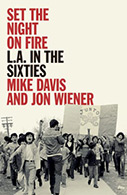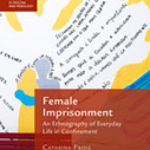Set The Night On Fire: L.A. In The Sixties

Authors: Mike Davis and Jon Wiener
Publisher: New York: Verso, 2020. 800p.
Reviewer: Andrew Baer | November 2020
In Set the Night On Fire, veteran writers and activists Mike Davis and Jon Wiener offer a page-turning survey of social movement activism in 1960s Los Angeles, revealing how the forces of resistance and repression ignited then still burn today. Organized chronologically and thematically, this large book introduces the reader to an array of liberals, progressives, and radicals who organized and fought for a variety of related causes, including civil rights, Black Power, feminism, gay liberation, sexual revolution, freedom of speech, global peace, fair housing, education reform, equitable healthcare, political representation, and more. While activists of all ages participated in the flurry of events, the authors focus particular attention on area youth, revealing a stunning degree of political savvy and courage among not only college-age adults, but high school children as well. Chronicling the activities of several famous individuals, such as Tom Bradley and Angela Davis, the book also recovers the work of countless lesser-known actors whose contribution to the political culture of L.A. deserves recognition. For example, the authors narrate the anti-war activism of Mary Clarke and Women Strike for Peace, the militant underground media of Art Kunkin and the LA Free Press, the subversive artwork of Sister Corita Kent of Immaculate Heart College, the revolutionary expression of Raul Ruiz and the Chicano Brown Berets, the organizing of Johnnie Tillman and the National Welfare Rights Organization, the cultural production of Mike Murase and the Asian American newspaper Gidra, and dozens more.
As might be expected of a “movement history” (7) of any American city, Set the Night On Fire devotes frequent attention to the role of local police. Indeed, the Los Angeles Police Department and other area law enforcement appear as constant foils to the righteous actions of local do-gooders and rabble-rousers. Not only were police officers present at virtually every moment of public activism, they also emerged as symbols of state repression and targets of protest. Davis and Wiener demonstrate how local police officers employed resources to surveille, disrupt, harass, silence, attack, imprison, and even kill people working to transform L.A. and its institutions. The authors explore key themes of law and society scholarship by demonstrating how law enforcement and social movements operate at the ground level.
At over 640 pages, Set the Night on Fire is long, but a quick read. The prose is sharp, impassioned, and excitable. The subject matter is relevant to readers from a variety of backgrounds. Educators will enjoy how the book is broken into three dozen short, distinct chapters, each of which could be read alone. High School and college syllabi on a range of related subjects might include Davis’s and Wiener’s account of, say, the gay rights protests following the police raid of the Black Cat Tavern, the Watts Uprising, the state violence of the Century City Riots, or the operation of Los Angeles’s innovative Free Clinic. Above all, Set the Night on Fire is a serious, informative book that is also a pleasurable, fun, and inspiring read.
Andrew S. Baer is an assistant professor of history at the University of Alabama at Birmingham. He is the author of Beyond the Usual Beating: The Jon Burge Police Torture Scandal and Social Movements for Police Accountability in Chicago (University of Chicago Press, 2020).


